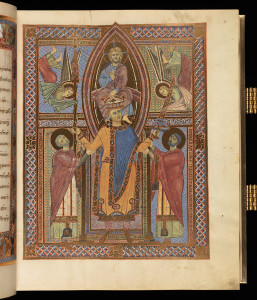by Julia Schneider, Medieval Studies Librarian
Notre Dame’s Medieval Institute has recently added the Sacramentary of Henry II to its substantial original-format facsimile collection. Original-format facsimiles are reproductions of important works that are intended to mimic the original. They are highly detailed, specialized, and provide insights into various aspects of intellectual history.

This sacramentary was a ceremonial service book for Mass to be used by the celebrant, and commissioned by Henry II, the Duke of Bavaria. Henry was crowned Holy Roman Emperor (1014-1024) by Boniface VIII and was known as a builder of the empire north of the Alps, as well as for being deeply religious. He considered himself to be “the Ruler of the House of God,” following in the footsteps of his not-so-distant ancestor, Charlemagne (d. 814), and thus was a great patron of the Bavarian church. The founder of the See of Bamberg, Henry and his wife Kunegunde were both canonized and are interred in the cathedral of Sts. Peter and Georg there.
Henry’s sacramentary is the epitome of a deluxe manuscript; it is made of calf and sheep skin, and its luxurious illuminations, decorated initials, elaborately designed marginalia, use of gold and silver lettering throughout the manuscript, and sumptuous goldsmith’s decorated binding with ivory decorative plate made this a book truly worthy of an emperor and one that the emperor thought worthy to celebrate the sacred liturgy. The original was produced in the scriptorium of the Benedictine monastery of St. Emmeram at Regensburg, later made its way to Bamberg, and is now in the Bayerische Staatsbibliothek in Munich, leaving its location in the vault only rarely. Unlike the original, the facsimile, though not inexpensive to purchase, is not priceless. Because it is not the original medieval manuscript, it may be handled, offering students and scholars the opportunity to learn about the sacramentary itself and aiding them in gaining insight into the history of medieval book production, liturgy, and art history.
 This work is licensed under a Creative Commons Attribution 4.0 International License.
This work is licensed under a Creative Commons Attribution 4.0 International License.
